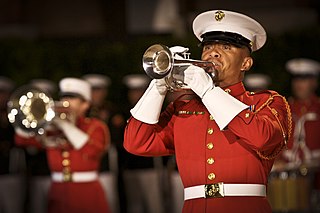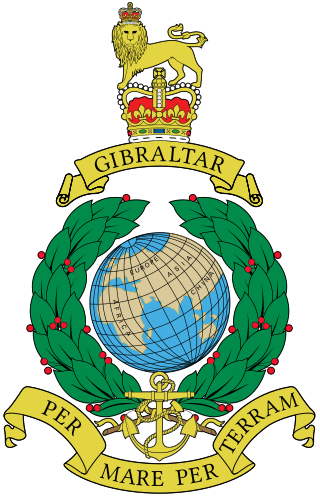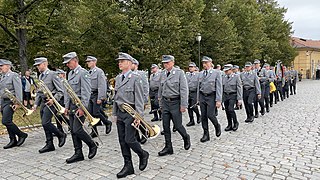
A military band is a group of personnel that performs musical duties for military functions, usually for the armed forces. A typical military band consists mostly of wind and percussion instruments. The conductor of a band commonly bears the title of Bandmaster or Music director. Ottoman military bands are thought to be the oldest variety of military marching bands in the world, dating from the 13th century.

Classic drum and bugle corps are musical ensembles that descended from military bugle and drum units returning from World War I and succeeding wars. Traditionally, drum and bugle corps served as signaling units as early as before the American Civil War, with these signaling units having descended in some fashion from ancient drum and fife corps. With the advent of the radio, bugle signaling units became obsolete and surplus equipment was sold to veteran organizations. These organizations formed drum and bugle corps of civilians and veterans, and the corps performed in community events and local celebrations. Over time, rivalries between corps emerged and the competitive drum and bugle corps circuit evolved.
The Brazilian Navy is the naval service branch of the Brazilian Armed Forces, responsible for conducting naval operations.

A fife and drum corps is a musical ensemble consisting of fifes and drums. In the United States of America, fife and drum corps specializing in colonial period impressions using fifes, rope tension snare drums, and (sometimes) rope tension bass drums are known as Ancient Fife and Drum Corps. Many of these ensembles originated from a type of military field music.

United States military bands include musical ensembles maintained by the United States Army, United States Marine Corps, United States Navy, United States Air Force, and United States Coast Guard. More broadly, they can also include musical ensembles of other federal and state uniformed services, including the Public Health Service and NOAA Corps, the state defense forces, and the senior military colleges.

The United States Marine Drum & Bugle Corps is the drum and bugle corps of the United States Marine Corps. The D&B is now the only active duty drum and bugle corps in the United States Armed Forces. One of many United States military bands, the United States Marine Drum & Bugle Corps usually consists of about 70 active-duty Marines dressed in ceremonial red and white uniforms. The D&B performs martial and popular music.

The Royal Marines Band Service is the musical wing of the Royal Navy and an independent element of the Royal Marines. It currently consists of five bands plus a training wing – the Royal Marines School of Music at HMS Nelson – and its headquarters is at HMS Excellent, Whale Island, Portsmouth.

The Brazilian Marine Corps, is the land combat branch of the Brazilian Navy. The Corps is specialised in amphibious warfare.

The Portuguese Marine Corps constitutes the Elite Marine Commandos and the Special Operations Branch of the Portuguese Navy. It has roles similar to the ones of the USMC Reconnaissance Battalions and of the Royal Marine Commandos and the 75th Ranger Regiment The Corps is specialised in air assault, amphibious warfare, anti-tank warfare, coastal reconnaissance and raiding, commando style raids, counterinsurgency, desert warfare, indirect fire support raiding, irregular warfare, ISTAR, jungle warfare, maneuver warfare, maritime interdiction, mountain warfare, providing security at naval base or shore stations, reconnaissance for gathering military intelligence, support special operations, tracking targets, urban warfare, and VBSS operations. It is an Elite Marine Commando Force, operating as a rapid-reaction force. Today's Corpo de Fuzileiros is the premier raid force. The Fuzileiros remains an all-volunteer force with an intensive screening and selection process followed by combat-focused training. Fuzileiros are resourced to maintain exceptional proficiency, experience and readiness.

Martial music or military music is a specific genre of music intended for use in military settings performed by professional soldiers called field musicians. Much of the military music has been composed to announce military events as with bugle calls and fanfares, or accompany marching formations with drum cadences, or mark special occasions as by military bands. However, music has been employed in battle for centuries, sometimes to intimidate the enemy and other times to encourage combatants, or to assist in organization and timing of actions in warfare. Depending on the culture, a variety of percussion and musical instruments have been used, such as drums, fifes, bugles, trumpets or other horns, bagpipes, triangles, cymbals, as well as larger military bands or full orchestras. Although some martial music has been composed in written form, other music has been developed or taught by ear, such as bugle calls or drum cadences, relying on group memory to coordinate the sounds.

A corps of drums, sometimes known as a fife and drum corps or simply field music, is a traditional European military music formation. In contrast to a military band, a Corps of Drums' primary role is communication. Historically, music was used as signaling device for keeping the march tempo and delivering commands. Today, the primary role of a Corps of Drums is ceremonial, performing in parades and military ceremonies. Besides drums, this formation may contain a variety of instruments, including trumpets, bugles, and fifes.

The Presidential Guard Battalion, also known as Duke of Caxias Battalion, or by its historical designation Emperor's Battalion, is a unit of the Brazilian Army and honour guard to the President of Brazil. Two other units, the 1st Guards Cavalry Regiment and the Cayenne Battery, are also part of the presidential honour guard unit. It is currently a part of the Planalto Military Command.

A fanfare band, fanfare corps, fanfare battery, fanfare team, horn and drum corps, bugle band, drum and bugle corps, or trumpet and drum band is a military or civilian musical ensemble composed of percussion instruments, bugles, natural horns and natural trumpets. Fanfare bands are the descendants of the old medieval trumpet and drum teams that sounded fanfares on important occasions and are related to drum and bugle corps internationally.

A drum major in the military is the individual leading a military band or a field unit. It is an appointment, not a military rank. Military drum majors utilize a ceremonial mace for giving commands while marching. Many drum majors, particularly American- or British-influenced ones, wear a sash that can carry embroidered badges of their home unit and battle honors; a pair of ceremonial drum sticks are often attached.

Canadian military bands are a group of personnel in the Canadian Armed Forces (CAF) that performs musical duties for military functions. Military bands form a part of the Music Branch of the CAF, composed of six full-time professional Regular Force bands, 15 Regular Force voluntary bands, and 53 part-time reserve force bands. Bands of the Music Branch are often badged with the unit or Canadian Forces base insignia that they support.

The Music of the Foreign Legion, formerly known as the Principal Music of the Foreign Legion is a Military band of the French Foreign Legion.

Sri Lankan military bands refer to the joint-service musical units of the Sri Lanka Armed Forces representing the Sri Lanka Army, the Sri Lanka Navy, and the Sri Lanka Air Force. The three bands mentioned, which were established in 1949, 1952 and 1970 respectively and are the seniormost in the armed forces. They are composed of many ceremonial marching bands as well as concert bands which are base for the band's success. The band participates in main social and cultural events, including formal state visits and military parades. All army regiments also contain a regimental band for ceremonial duties.

The Rotterdam Marine Band of the Royal Netherlands Navy, also referred to as the Band of the Korps Mariniers or simply the Dutch Marine Band is the Royal Netherlands Navy's official musical unit. Like Britain's Royal Marines Band Service it is the representative band of the entire navy despite being a reporting unit of the Korps Mariners, as sub-branch in the Dutch Armed Forces. Based in the port city of Rotterdam, the band was founded on 1 August 1945 as a continuation of the pre-war Regimental Band of the Royal Netherlands Navy.

The Marine Corps Musician Enlistment Option Program (MEOP) is the central organized body overseeing the active-duty military bands of the United States Marine Corps. Marine Corps field bands can be found in the Southeast United States, Southern California, and the Pacific-Asia region. While serving with their bands, Marines perform throughout the continental United States and travel internationally to locations ranging from Beijing to Paris. These units take part in activities such as retirement ceremonies, the Marine Corps Birthday Ball, funerals, change of commands, and civil/military parades. It is one of two music programs in the Department of the Navy, with the other being Fleet Band Activities.

The military bands of the United Kingdom are musical units that serve for protocol and ceremonial duties as part of the British Armed Forces. They have been the basis and inspiration for many military bands in the former British Empire and the larger Commonwealth of Nations as well as musical organizations in other countries. Military musical units with British influence include United States military bands, the Japan Ground Self-Defense Force Music Corps and the Military Band of Athens. British military bands are controlled by the military music departments of the three services that compose the armed forces. These include the Royal Marines Band Service, the Royal Corps of Army Music, and the Royal Air Force Music Services. British style brass bands and carnival bands were then and are currently inspired by the British Armed Forces and its brass bands, especially of the Army's regular and reserve formations, as they follow a similar format as it relates to brass and percussion instruments.



















